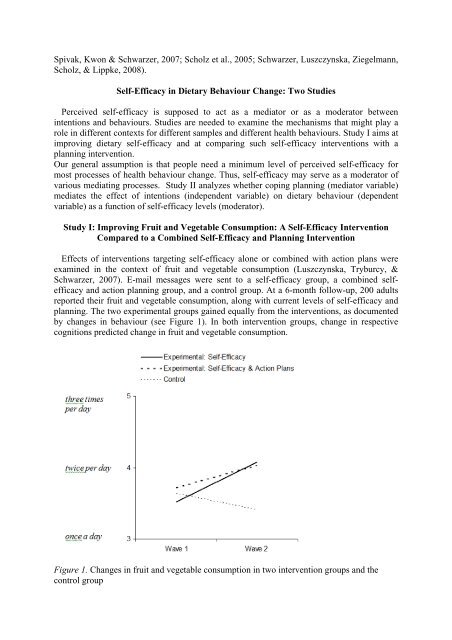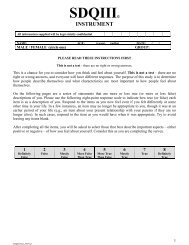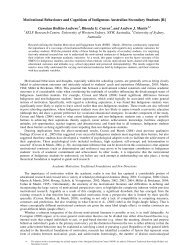Perceived Self-Efficacy in Health Behaviour Change The Construct of
Perceived Self-Efficacy in Health Behaviour Change The Construct of
Perceived Self-Efficacy in Health Behaviour Change The Construct of
Create successful ePaper yourself
Turn your PDF publications into a flip-book with our unique Google optimized e-Paper software.
Spivak, Kwon & Schwarzer, 2007; Scholz et al., 2005; Schwarzer, Luszczynska, Ziegelmann,<br />
Scholz, & Lippke, 2008).<br />
<strong>Self</strong>-<strong>Efficacy</strong> <strong>in</strong> Dietary <strong>Behaviour</strong> <strong>Change</strong>: Two Studies<br />
<strong>Perceived</strong> self-efficacy is supposed to act as a mediator or as a moderator between<br />
<strong>in</strong>tentions and behaviours. Studies are needed to exam<strong>in</strong>e the mechanisms that might play a<br />
role <strong>in</strong> different contexts for different samples and different health behaviours. Study I aims at<br />
improv<strong>in</strong>g dietary self-efficacy and at compar<strong>in</strong>g such self-efficacy <strong>in</strong>terventions with a<br />
plann<strong>in</strong>g <strong>in</strong>tervention.<br />
Our general assumption is that people need a m<strong>in</strong>imum level <strong>of</strong> perceived self-efficacy for<br />
most processes <strong>of</strong> health behaviour change. Thus, self-efficacy may serve as a moderator <strong>of</strong><br />
various mediat<strong>in</strong>g processes. Study II analyzes whether cop<strong>in</strong>g plann<strong>in</strong>g (mediator variable)<br />
mediates the effect <strong>of</strong> <strong>in</strong>tentions (<strong>in</strong>dependent variable) on dietary behaviour (dependent<br />
variable) as a function <strong>of</strong> self-efficacy levels (moderator).<br />
Study I: Improv<strong>in</strong>g Fruit and Vegetable Consumption: A <strong>Self</strong>-<strong>Efficacy</strong> Intervention<br />
Compared to a Comb<strong>in</strong>ed <strong>Self</strong>-<strong>Efficacy</strong> and Plann<strong>in</strong>g Intervention<br />
Effects <strong>of</strong> <strong>in</strong>terventions target<strong>in</strong>g self-efficacy alone or comb<strong>in</strong>ed with action plans were<br />
exam<strong>in</strong>ed <strong>in</strong> the context <strong>of</strong> fruit and vegetable consumption (Luszczynska, Tryburcy, &<br />
Schwarzer, 2007). E-mail messages were sent to a self-efficacy group, a comb<strong>in</strong>ed selfefficacy<br />
and action plann<strong>in</strong>g group, and a control group. At a 6-month follow-up, 200 adults<br />
reported their fruit and vegetable consumption, along with current levels <strong>of</strong> self-efficacy and<br />
plann<strong>in</strong>g. <strong>The</strong> two experimental groups ga<strong>in</strong>ed equally from the <strong>in</strong>terventions, as documented<br />
by changes <strong>in</strong> behaviour (see Figure 1). In both <strong>in</strong>tervention groups, change <strong>in</strong> respective<br />
cognitions predicted change <strong>in</strong> fruit and vegetable consumption.<br />
Figure 1. <strong>Change</strong>s <strong>in</strong> fruit and vegetable consumption <strong>in</strong> two <strong>in</strong>tervention groups and the<br />
control group





